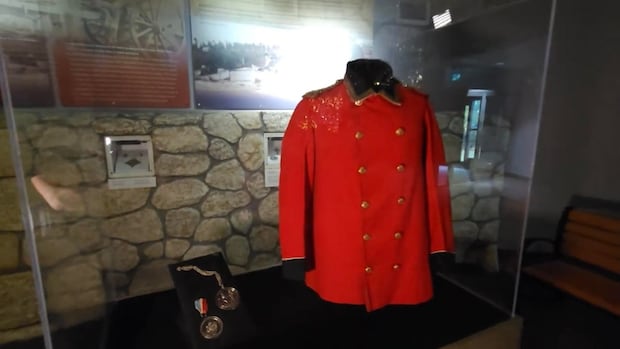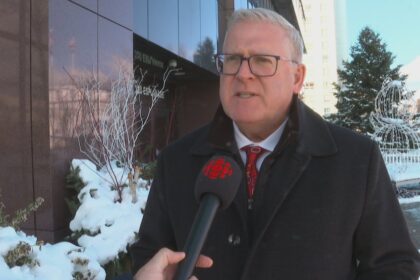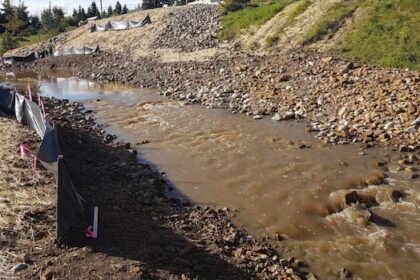Indigenous·NewThe signed Treaty 5 document, a Treaty 5 medal, and a jacket presented to original signatory Chief Jacob Berens were on display last week for the Summit of Treaty 5 Sovereign Nations at Lower Fort Garry National Historic Site, north of Winnipeg.150th anniversary of Treaty 5 marked with gathering at Lower Fort Garry near WinnipegStefan Richard · CBC News · Posted: Sep 24, 2025 2:05 PM EDT | Last Updated: 26 minutes agoThe jacket of Chief Jacob Berens, one of the original signatories to Treaty 5, on display at Lower Fort Garry near Winnipeg last week. (Kevin Nepitabo/CBC)It’s been 150 years since three historic items that were present at the signing of Treaty 5 have been together.The signed Treaty 5 document, a Treaty 5 medal, and a jacket presented to original signatory Chief Jacob Berens were on display last week for the Summit of Treaty 5 Sovereign Nations at Lower Fort Garry National Historic Site, north of Winnipeg.The last time these items were all together was in September 1875 when the treaty was being signed.”You feel the gravity of what our ancestors wanted for us in the future and you see their mark on what they believed was right for us in the future,” said Wapastim Harper, a student intern with the Summit of Treaty 5 Sovereign Nations.Harper, a member of Berens River and Garden Hill First Nations, was part of the team that worked to get the items to Lower Fort Garry for the anniversary and said people were excited to see the items. “They see the signatures; they see the jacket and they just get filled with glee and they’re saying … ‘My ancestors’ hands … touched these items,'” he said.Wapastim Harper is a student/intern with the Summit of Treaty 5 Sovereign Nations and helped arrange to have Treaty 5 items brought to the gathering. (Kevin Nepitabo/CBC)Treaty 5 between Canada and the Swampy Cree and Saulteaux people, signed in 1875 and 1876, covers land in central Manitoba, as well as small parts of Saskatchewan and Ontario. The agreement set aside reserve lands for the First Nations, promised schools and affirmed hunting and fishing rights.WATCH | Treaty 5 gathering brings items together at Lower Fort Garry: Treaty 5 document returns to ManitobaFirst Nations in Treaty 5 territory welcomed the chance to see the historic treaty document in person to mark the 150th anniversary of its signing. Chief Berens, one of the first leaders to sign the treaty, was given a jacket from the Dominion of Canada at the time of signing. It was paired with a gift of a Treaty 5 medal to each signatory.The family of Chief Berens donated the jacket and medals to the Manitoba Museum in Winnipeg in 2011 for preservation purposes. The treaty is stored by Library and Archives Canada in its facility in Gatineau, Que.Massive crateThere were challenges moving such an old document. Libraries and Archives Canada hired an art-specific moving team to drive it to Winnipeg. The team had to keep the case level throughout the entire transport process as not to damage it.Amelia Fay, curator of anthropology and the HBC Collection at the Manitoba Museum, said actually moving the treaty document into the building at Lower Fort Garry was the hardest thing.”It’s not heavy but it was in a massive crate that required double doors to be opened and a lot of their doors have a metal pole in the middle,” she said.The document was displayed in a darkened room for preservation purposes. Prolonged exposure to bright light would cause the ink to fade over time.Chief Clarence Easter of Chemawawin Cree Nation viewed the Treaty 5 items last week. (Kevin Nepitabo/CBC)Chemawawin Cree Nation Chief Clarence Easter said seeing the century-and-a-half old items had an impact.”We need to look at, you know, how we’re going to live for the next 150 years,” he said.”We knew how to live 150 years past but we have to determine, we cannot live the same way. We’ve got to make our lives better than what they were before.”ABOUT THE AUTHORStefan Richard is a reporter for CBC Indigenous, based in Treaty 1 territory. His work has appeared on APTN, NPR, Corus Radio, Native Communications Inc., and Slam Wrestling. Stefan is a proud member of Sagkeeng Anicinabe Nation.
Friday, 26 Dec 2025
Canada – The Illusion
Search
Have an existing account?
Sign In
© 2022 Foxiz News Network. Ruby Design Company. All Rights Reserved.
You May also Like
- More News:
- history
- Standing Bear Network
- John Gonzalez
- ᐊᔭᐦᑊ ayahp — It happened
- Creation
- Beneath the Water
- Olympic gold medal
- Jim Thorpe
- type O blood
- the bringer of life
- Raven
- Wás’agi
- NoiseCat
- 'Sugarcane'
- The rivers still sing
- ᑲᓂᐸᐏᐟ ᒪᐢᑿ
- ᐅᑳᐤ okâw — We remember
- ᐊᓂᓈᐯᐃᐧᐣ aninâpêwin — Truth
- This is what it means to be human.
- Nokoma










